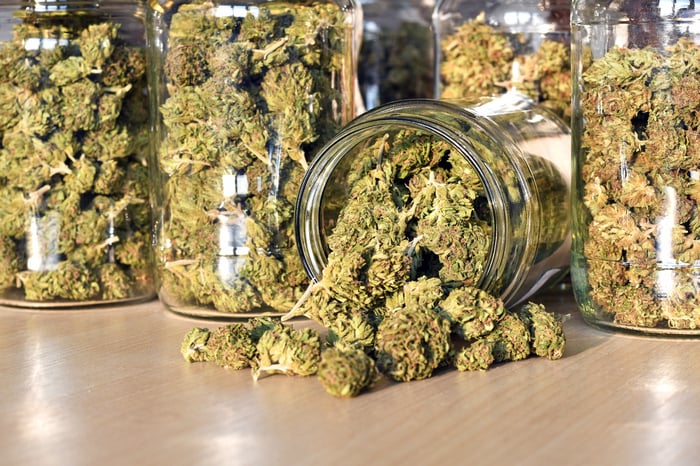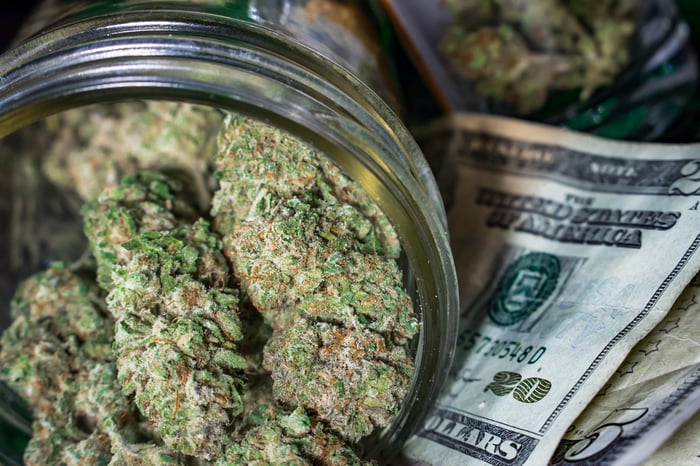Following years of promises from Prime Minister Justin Trudeau and months of debate in Canada's Parliament, our neighbor to the north is officially legalizing recreational marijuana for adults as of today, Oct. 17, 2018. The passage of the Cannabis Act on June 19, 2018, and the waving of the proverbial green flag today, ends approximately nine decades of adult-use prohibition.
What does that mean exactly on a bigger-picture scale, as well as for marijuana investors? Let's take a closer look at the 20 things you'll want to know about today's historic event.

Image source: Getty Images.
1. Legalization varies by province
To begin with, although the Cannabis Act (bill C-45) legalizes adult-use cannabis throughout Canada, the country's provinces are free to tweak the rules and regulations as they see fit. This might mean raising the legal purchasing age to 19, or keeping it at 18, as in Alberta and Quebec. Provinces also have the final say on where consumers can purchase marijuana (i.e., private or government-run dispensaries, and online), and whether they can grow it in their homes.
2. Foreign markets should generate a majority of long-term revenue
Sure, legalizing marijuana in Canada is historic, as it represents the first time an industrialized nation has given the green light to recreational weed. But don't expect the domestic market to be the long-term breadwinner for the industry. According to Health Canada, domestic demand is only expected to hit around 1 million kilograms annually. By comparison, foreign markets where medical weed is legal could gobble up more than double this amount each year, making them far more important in the grand scheme of things for Canadian pot stocks.
3. Not all consumption types are legalized
Keep in mind that just because marijuana is legalized, it doesn't mean all forms of consumption will be on dispensary shelves. The Cannabis Act specified that only dried marijuana flower and cannabis oils are legal for sale as of today, with alternative products like edibles, vapes, concentrates, and cannabis-infused beverages not yet allowed for sale.

Image source: Getty Images.
4. It's unclear when many alternative products will get the green light
Industry experts and the marijuana companies themselves expect these aforementioned alternative pot products to get the OK for sale from Health Canada in 2019. However, there is no concrete timeline as to when Parliament will discuss expanding the options for consumption, meaning it's more guesswork than anything at this point.
5. Alternative cannabis products are what will provide differentiation
Why so much attention to alternative cannabis products? Simple: They tend to be a considerably higher-margin product than dried flower, and they face much less long-term pricing pressures. These alternatives, including oils, vapes, and infused beverages, will also be pivotal in helping marijuana stocks stand out from their competition. A perfect example is Aphria's (NASDAQOTH: APHQF) construction of a cannabis extraction facility capable of 25,000 kilograms per year of equivalent concentrate production.
6. Pot excise taxes are exceptionally low, relative to alcohol
Canada is making a concerted effort to go after illicit marijuana sales by placing an exceptionally low excise tax on legal weed sales. This excise tax works out to about 10%, which is considerably lower than the excise tax placed on beer, wine, and spirits of between 50% and 80% in Canada.

Image source: Getty Images.
7. The black market isn't going away
However, even a relatively low excise tax isn't going to be enough to completely push the black market out of Canada -- at least initially. Illicit cannabis players don't have to pay excise taxes, federal income, or fees for cultivation and sales licenses. There are also, presumably, lower overhead costs for illicit players. This allows the black market to easily undercut legal-channel pricing, which could become a bigger problem than investors and pot companies realize.
8. Marijuana sales are about to soar
Despite persistent threats from the black market, weed sales are about to absolutely soar, and marijuana stock investors know it. Industry giants like Canopy Growth Corp. (CGC -3.13%) and Aurora Cannabis (ACB -1.86%) are expected to see their sales climb a respective 355% and 639% this fiscal year, and 157% and 119% next year.
9. However, production is nowhere near capacity
Then again, for as quickly as revenue is expected to rise in the quarters to come, investors should also understand that production capacity will be nowhere near its peak right out of the gate. For instance, Aurora Cannabis is aiming for 100,000 kilograms of annual run rate capacity by the end of 2018, but ultimately expects to produce in excess of 570,000 kilograms when it's up to full speed. Aurora, like Canopy Growth, Aphria, and every other marijuana stock out there, has years to go before output comes anywhere near optimal.

Image source: Getty Images.
10. Oversupply remains a long-term concern
But when production capacity for a majority of marijuana stocks does hit its peak, the industry could run into serious oversupply concerns. Based on current projections, Canadian companies look to easily exceed 3 million kilograms in annual production by, say, 2020 or 2021, meaning foreign markets will need to buy quite a bit of pot. If marijuana stocks struggle to move this excess capacity, it could be a recipe for a notable decline in per-gram dried flower prices.
11. A handful of marijuana stocks could control more than half of the market
Interestingly enough, when cannabis producers hit their stride, just a very small handful of growers could control more than half of the market. Based on my own rough calculations, Aurora Cannabis will (once its ICC Labs acquisition closes) exceed 600,000 kilograms, with Canopy Growth and Aphria chiming in with around 500,000 kilograms and 255,000 kilograms of their own. Add in Tilray and The Green Organic Dutchman, and these five pot stocks could be responsible for as much as 1.8 million kilograms of output combined by 2020 or 2021.
12. All Canadian pot profits should come with an asterisk, at this point
Do marijuana stocks have you seeing green in the profit column? Well, take your blinders off. Despite a handful of pot stocks having produced encouraging profits to date, practically all of this income is a result of (legal) International Financial Reporting Standards (IFRS) accounting in Canada. In simple terms, Canadian-reporting pot companies are able to adjust the valuation of their cannabis plants whenever they choose, leading to many reporting a profit, with a pretty big asterisk.

Image source: Getty Images.
13. Most pot stocks are well capitalized
While their profits may be nothing more than accounting smoke and mirrors at this point, marijuana companies aren't lying when they tout their cash-rich balance sheets. Understanding the need to expand their growing capacity rapidly, build their international infrastructure, and develop their brands, pot stocks haven't been shy about capital raises. When Corona and Modelo beer maker Constellation Brands (STZ -0.18%) closes its $3.8 billion equity stake in Canopy Growth, Canopy will be sporting more than $4 billion in cash on hand.
14. Non-dilutive financing options are now available to pot companies
Until the passage of the Cannabis Act on June 19, publicly traded Canadian marijuana stocks pretty much had but one means of raising capital: bought-deal offerings. These offerings involve the sale of common stock, convertible debentures, stock options, and/or warrants to an investor or group of investors in order to raise capital. Of course, with marijuana now legal, non-dilutive options, including bank loans and lines of credit, are now at the disposal of cannabis companies.
15. Share-based dilution is a multiyear issue
Though bought-deal offerings were necessary to fuel expansion in the marijuana industry, they're also going to have an adverse impact on pot stocks (and investors) over the long run. By selling stock, debt that can be converted to stock, and options or warrants that can be exercised into stock, pot companies have ballooned their outstanding share counts. Aurora Cannabis, for example, could soon surpass 1 billion shares outstanding after having just 16.2 million shares outstanding a little over four years ago. These extra shares not only dilute existing investors, but they make it that much harder for a cannabis stock to turn a meaningful per-share profit.

Image source: Getty Images.
16. Expect dealmaking to continue
Growth within the cannabis industry is undeniable, which means that companies outside the pot industry are taking notice. As mentioned earlier, Constellation Brands is taking a massive stake in Canopy Growth that'll give it 38% ownership in the company. Constellation and Canopy will be collaborating on alternative cannabis products, as well as using Constellation's superior distribution and marketing prowess, to expand Canopy's reach (where weed is legal, of course). Expect deals like this -- although perhaps not to this magnitude -- to continue.
17. Don't forget about ancillary businesses
Investors are so focused on companies that come in direct contact with the cannabis plant that they've almost forgotten about the ancillary businesses working in the background to prop up this industry. Think of companies like KushCo Holdings (KSHB), which are supplying packaging, branding, and marketing solutions to pot companies worldwide in order to keep them compliant with local laws. KushCo also provides hydrocarbon gases and solvents used in the production of cannabis oils and concentrates. These ancillary stocks have the potential to produce even bigger gains than growers.
18. There's life beyond Canada
It's probably worth pointing out that while all investors are focused on Canada, there's a world of cannabis beyond the Canadian border. Just to the south, 30 states in the U.S. have legalized cannabis in some capacity since 1996. In fact, California's recreational marijuana industry may generate more in annual sales than all of Canada. In other words, even though Canada is a marijuana maverick of sorts, there are plenty of other opportunities out there.

Image source: Getty Images.
19. Volatility is a way of life
If you're planning to invest in marijuana stocks, you should expect a bumpy ride. Clearly, there will be winners. But it also means there could be pot stocks that completely go belly-up. With little precedence to recreational legalization, few investors know how to approach these stocks, which is leading to a lot of volatility. Take Tilray, which shot like a cannon from $25 a share to $300 in four weeks, then promptly gave back two-thirds of its value in the following three days.
20. History says marijuana stocks are in a bubble
Last, but not least, the thing no investor wants to hear: Marijuana stocks are almost assuredly in a bubble, and it may not end well. There hasn't been a "next big thing" investment over the past quarter century that's rallied like marijuana stocks have and held its gains over the long run. The internet, business-to-business commerce, genomics, 3D printing, and blockchain have all seen their bubbles burst. Chances are that marijuana stocks will face a similar fate.





